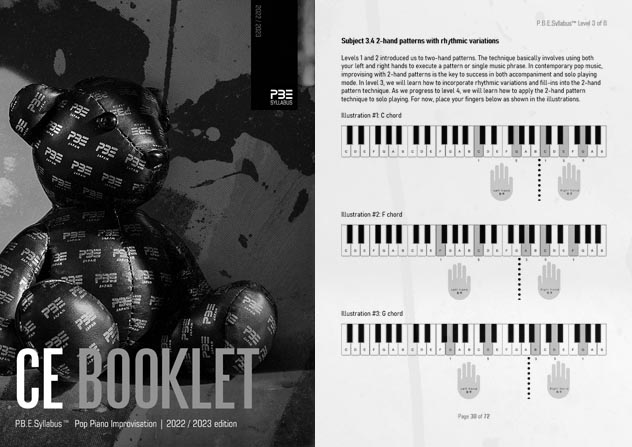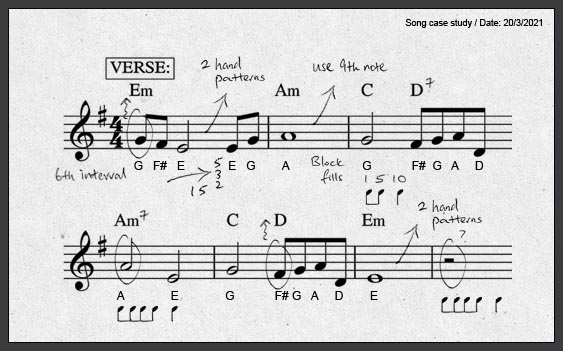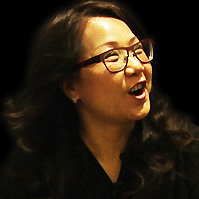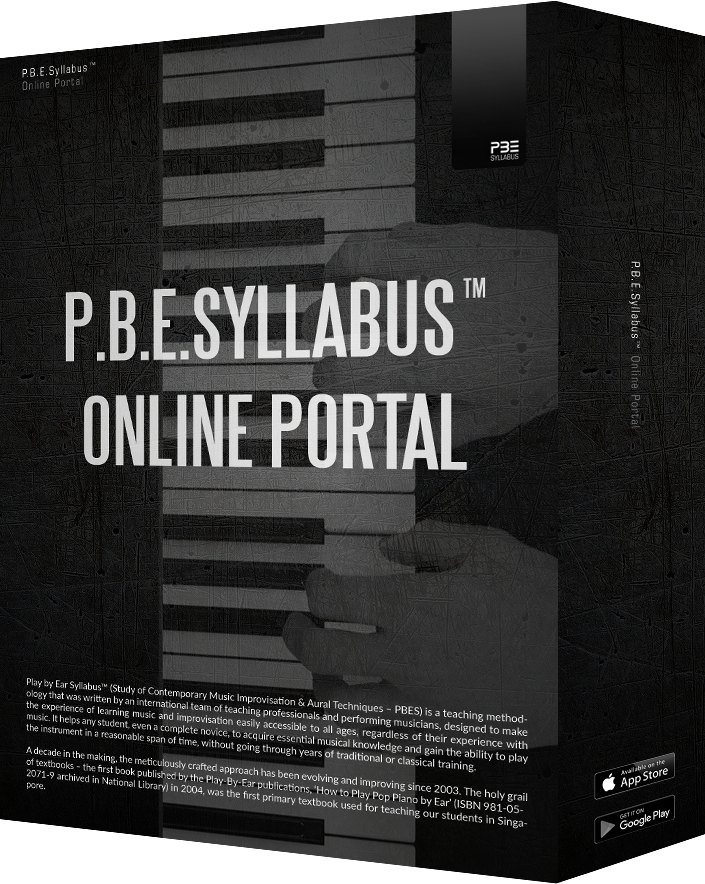Pop Piano lessons
for adults
Our pop piano lessons (for adults) encompass all levels, including complete beginners, since 2003 in Singapore. As opposed to a traditional pianist, a pop pianist plays and embellishes a song. Our Pop piano lessons (for adults) cover improvisation techniques that can be applied to any song of your choice, including English, Chinese, J-Pop, K-Pop, worship, etc. Learn the art of piano improvisation and begin your musical journey with us today.
Pop Piano lessons (for adults) administrative information:
Course Title: P.B.E.S™ Pop Piano Improvisation Course (for adults)
Age group: for Adults and Teens
Lesson duration: 45 mins one-on-one (individual)
Lessons frequency: 1 lesson per week
Prerequisite: Zero music background
Available levels: P.B.E.S™ Level 1 – 8
Adults with zero background can enroll to P.B.E.S™ Level 1. The entire course can also be fully customized upon request (without following the P.B.E.Syllabus™) In addition, when you enroll for the P.B.E.S™ Pop Piano Improvisation course, you will receive the following incentives, exclusive to PBE students:
a) P.B.E.S™ CE booklet for current P.B.E.S™ Level
b) Login ID and Password for P.B.E.I.S™ Online Student Portal APP & Whatsapp Newsfeed
c) Free usage of practice studios (Room 5/Level 3)
d) Free scores transcribing service
e) Discounts on musical instruments
Learn the right way to play Pop Piano
Generally, there are two main routes to learning piano: Pop or Classical. Either is fine, depending on personal interest. What matters more is how you learn, not which genre you choose.
Before we go through the details of our Pop Piano Improvisation course, we encourage you to watch the following two videos. They highlight a common problem in music education: most students focus on reading and memorizing scores and playing note-for-note, rather than learning to improvise. This approach is typical in Classical piano, where students often prepare set pieces solely to pass exams. Since the primary focus is on passing grades, it doesn’t matter whether the learning approach is correct or not. Here’s the issue: ask a friend who passed Classical Grade 8 to play a simple song, like Happy Birthday, on the spot using both hands, without scores. Often, they can’t. This defeats the purpose of learning music. Music is a language — improvisation is its “speaking” component. Imagine learning a language (e.g. Japanese) for 10 years but only being able to read, not speak.
We would like to gently emphasize again that there’s nothing wrong with learning Classical piano, and Pop piano isn’t the ‘solution’. The problem lies in the learning approach. At PBE, regardless of the genre, we focus on the right learning approach, teaching the four core aspects of music as a language: reading, writing, listening, and especially speaking (improvisation).
Generally, there are two main routes to learning piano: Pop or Classical. Either is fine, depending on personal interest. What matters more is how you learn, not which genre you choose.
Before we go through the details of our Pop Piano Improvisation course, we encourage you to watch the following two videos. They highlight a common problem in music education: most students focus on reading and memorizing scores and playing note-for-note, rather than learning to improvise. This approach is typical in Classical piano, where students often prepare set pieces solely to pass exams. Since the primary focus is on passing grades, it doesn’t matter whether the learning approach is correct or not.
[ Click here to read more ]
Here’s the issue: ask a friend who passed Classical Grade 8 to play a simple song, like Happy Birthday, on the spot using both hands, without scores. Often, they can’t. This defeats the purpose of learning music. Music is a language — improvisation is its “speaking” component. Imagine learning a language (e.g. Japanese) for 10 years but only being able to read, not speak.
We would like to gently emphasize again that there’s nothing wrong with learning Classical piano, and Pop piano isn’t the ‘solution’. The problem lies in the learning approach. At PBE, regardless of the genre, we focus on the right learning approach, teaching the four core aspects of music as a language: reading, writing, listening, and especially speaking (improvisation).
The second video you are about to watch was not created for any commercial purpose for our school. Its sole intention is to support and demonstrate our claim based on real interactions with real people. To be clear, the video is fully unscripted. It was filmed over two full days in November 2023 on the streets of Bugis. If we were to re-shoot it, the results would be the same. A total of 76 people were interviewed, 22 of whom had a background in classical piano. Out of those 22, only 3 were still able to play; the rest admitted they had “lost touch.”
This raises an important question: what is the point of learning piano if the skill is ultimately forgotten? When you learn a true skill, it should stay with you for life. Think about swimming or riding a bicycle — even if you haven’t done it in ten years, you can still do it. Music should be no different. Music is a language, and to internalize it, you must learn to speak it — to understand, express, and improvise freely, not just memorize and reproduce.
The video may have seemed to favor Pop Piano over Classical Piano. This is because learning Pop Piano generally involves improvising with chords. Choosing the wrong approach to learning Pop Piano — simply memorizing and reproducing — can lead to the same outcome as the wrong approach in Classical Piano
As repeated, regardless of the genre, we focus on the right learning approach, teaching the four core aspects of music as a language: reading, writing, listening, and especially speaking (improvisation).
The second video you are about to watch was not created for any commercial purpose for our school. Its sole intention is to support and demonstrate our claim based on real interactions with real people. To be clear, the video is fully unscripted. It was filmed over two full days in November 2023 on the streets of Bugis. If we were to re-shoot it, the results would be the same. A total of 76 people were interviewed, 22 of whom had a background in classical piano. Out of those 22, only 3 were still able to play; the rest admitted they had “lost touch.”
[ Click here to read more ]
This raises an important question: what is the point of learning piano if the skill is ultimately forgotten? When you learn a true skill, it should stay with you for life. Think about swimming or riding a bicycle — even if you haven’t done it in ten years, you can still do it. Music should be no different. Music is a language, and to internalize it, you must learn to speak it — to understand, express, and improvise freely, not just memorize and reproduce.
The video may have seemed to favor Pop Piano over Classical Piano. This is because learning Pop Piano generally involves improvising with chords. Choosing the wrong approach to learning Pop Piano — simply memorizing and reproducing — can lead to the same outcome as the wrong approach in Classical Piano
As repeated, regardless of the genre, we focus on the right learning approach, teaching the four core aspects of music as a language: reading, writing, listening, and especially speaking (improvisation).
Pop Piano Improvisation P.B.E.Syllabus™
P.B.E.S™ Level 1
Content for P.B.E.S™ Level 1
(in conjunction with P.B.E.Syllabus™)
1:1 | RH single note melody
1:2 | LH root note
1:3 | LH 1+5 interval
1:4 | LH Broken chord 1-5-8
1:5 | Diatonic triads (1+3+5)
1:6 | 2 hand patterns
1:7 | Variation intervals & broken
1:8 | Ending a song
Improvisation (Choice of songs)
Level 1 Ear training
Objectives for P.B.E.S™ Level 1:
- The ability to play an elementary piece of music on the piano
- Applying the rudiments of music
- Developing proper fingering and basic coordination skills
P.B.E.S™ Level 1 prerequisite:
- Total zero music background
Duration for P.B.E.S™ Level 1:
3* months (depending on individual's progress) *maximum
Download Level 1 syllabus
P.B.E.S™ Level 2
Content for P.B.E.S™ Level 2
(in conjunction with P.B.E.Syllabus™)
2:1 | Introduction to Level 2
2:2 | LH Broken chord 1-5-10
2:3 | LH Broken chord 1-5-1-3-5
2:4 | Octave displacement
2:5 | Slash chords and inversions
2:6 | LH (1-5-3-5-8)
2:7 | 2 hand pattern with m7
2:8 | Variation between 3&5 notes
Improvisation (Choice of songs)
Level 2 Ear training
Objectives for P.B.E.S™ Level 2::
- The ability to play in both 4 & 8 beat rhythm (with or without reading)
- Able to apply basic improvisation
P.B.E.S™ Level 2 prerequisite:
- Able to play elementary tunes with two hands
- No chord knowledge required
Duration for P.B.E.S™ Level 2:
3* months (depending on individual's progress) *maximum
Download Level 2 syllabus
P.B.E.S™ Level 3
Content for P.B.E.S™ Level 3
(in conjunction with P.B.E.Syllabus™)
3:1 | Introduction to Level 3
3:2 | The 9th note
3:3 | 6th interval RH harmonisation
3:4 | 2 hand patterns rhythmic
3:5 | Directional change
3:6 | Fill-ins using motifs
3:7 | Basic syncopation rhythm
3:8 | Variation interval/3/5notes
Improvisation (Choice of songs)
Level 3 Ear training
Objectives for P.B.E.S™ Level 3:
- The ability to interpret fake sheets with basic improvisation
- Use of right hand in playing harmony and basic fill-ins (2 hand patterns)
P.B.E.S™ Level 3 prerequisite:
- Previous classical piano background (Grade 3 & above) or self taught
Duration for P.B.E.S™ Level 3:
4*-9 months (depending on individual's progress) *minimum
Download Level 3 syllabus
P.B.E.S™ Level 4
Content for P.B.E.S™ Level 4
(in conjunction with P.B.E.Syllabus™)
4:1 | LH broken + broken
4:2 | LH block 1+5+7
4:3 | 2-hand patterns in solo
4:4 | Introduction to 16 beat
4:5 | Basic syncopation 16beat rhythm
4:6 | Left hand wide playing (fill-ins)
4:7 | Accenting on last beat
4:8 | Variation between 8&16 beat
Improvisation (Choice of songs)
Level 4 Ear training
Objectives for P.B.E.S™ Level 4:
- The ability to comfortably execute improvisation variations on left and right hand with song arrangements
- Usage of 9th notes for all major and minor triads in easy keys
P.B.E.S™ Level 4 prerequisite:
- Completion of P.B.E.S™ Level 3
Duration for P.B.E.S™ Level 4:
3*months (depending on individual's progress) *minimum
Download Level 4 syllabus
P.B.E.S™ Level 5
Content for P.B.E.S™ Level 5
(in conjunction with P.B.E.Syllabus™)
5:1 | LH block 1+5+7
5:2 | LH 16th beat pattern I
5:3 | LH 16th beat pattern II
5:4 | Closing playing w intervals
5:5 | 2 hand patterns - 9th notes
5:6 | Rock patterns
5:7 | Variation - 16th beat
5:8 | Melody improvisation I
Improvisation (Choice of songs)
Level 5 Ear training
Objectives for P.B.E.S™ Level 5:
- The ability to play in 16 beat rhythm
- Application of maj7 , m7 and sus4
- Triplets in 8 & 16beat rhthm
- Able to improvise a song at will with or without fakesheet
P.B.E.S™ Level 5 prerequisite:
- Completion of P.B.E.S™ Level 4
Duration for P.B.E.S™ Level 5:
3* months (depending on individual's progress) *minimum
Download Level 5 syllabus
P.B.E.S™ Level 6
Content for P.B.E.S™ Level 6
(in conjunction with P.B.E.Syllabus™)
6:1 | LH approach notes
6:2 | Adv. RH harmonisation I
6:3 | V aug7, V11/13, Vb9 reharmonisation
6:4 | Advanced comping I
6:5 | Right hand fill-ins (16 beat pattern)
6:6 | Close playing using scale notes
6:7 | Voicings with 7th and 9th
6:8 | Melody improvisation II
Improvisation (Choice of songs)
Level 6 Ear training
Objectives for P.B.E.S™ Level 6:
- The ability to play in 16 beat rhythm with 8 beat variations
- Able to apply voice leading
- Able to improvise a melody with given chord progressions
P.B.E.S™ Level 6 prerequisite:
- Completion of P.B.E.S™ Level 5
Duration for P.B.E.S™ Level 6:
3 months* (depending on individual's progress) *minimum
Download Level 6 syllabus
P.B.E.S™ Level 7
Content for P.B.E.S™ Level 7
(in conjunction with P.B.E.Syllabus™)
7:1 | RH approach notes
7:2 | Adv. RH harmonisation II
7:3 | Improvising with triplets
7:4 | (ii-V-I) reharmonisation
7:5 | Advanced intros and endings
7:6 | Advanced comping II
7:7 | Key modulations
7:8 | Chord identifying
Improvisation (Choice of songs)
Level 7 Ear training
Objectives for P.B.E.S™ Level 7:
- To explore other uptempo contemporary genres
- To introduce to Pop-Jazz
- The ability to perform re-harmonisation
- The ability to improvise a tune with advanced arrangements
P.B.E.S™ Level 7 prerequisite:
- Completion of P.B.E.S™ Level 6
Duration for P.B.E.S™ Level 6 :
4* months (depending on individual's progress) *minimum
Download Level 7 syllabus
P.B.E.S™ Level 8
Content for P.B.E.S™ Level 8
(in conjunction with P.B.E.Syllabus™)
8:1 | Melody rhythm displacement
8:2 | RH harmonisation disp.
8:3 | Blues and pentatonic
8:4 | Advanced song rendition
8:5 | Common note riffs
8:6 | Advanced comping III
8:7 | Rhythmic improvisation
8:8 | Transcribing & playing by ear
Improvisation (Choice of songs)
Level 8 Ear training
Objectives for P.B.E.S™ Level 8:
- The ability to play by ear
- To be able to interpret songs with self arranged rendition using rhythmic displacement and re-harmonization
P.B.E.S™ Level 8 prerequisite:
- Completion of P.B.E.S™ Level 7
Duration for P.B.E.S™ Level 8:
4* months (depending on individual's progress) *minimum
Download Level 8 syllabus

P.B.E.S™ Pop Piano Improvisation course (for adults) CE booklet
Updated: 1 Sept 2025 Edition 13.1
√ 2 hand patterns introduced in P.B.E.S™ Level 1 for comping
√ Quarter and quaver fill-ins introduced in P.B.E.S™ Level 3 for comping
√ Block chord style 1+3+5 for P.B.E.S™ Level 1
√ Introducing relative major and minor triads to 2-hand patterns in P.B.E.S™ Level 2
√ Introduction of basic syncopation rhythm in P.B.E.S™ Level 3 for uptempo genres
Below is a case study example of an excerpt from the song “Sadness and Sorrow (Naruto OST)” improvised using techniques from each of the 8 P.B.E.S™ levels (Level 1-8). These 4 videos will provide you with an idea of what you will learn at different levels during your piano lessons. The song example was chosen at random and demonstrated in solo-playing. As a student, you will learn a song of your choice and apply the same techniques, either through solo-playing, accompaniment (play and sing), or both.
Here is what you should achieve after P.B.E.S™ Level 1 / 2
Techniques included (but not limited to) LH 1-5-8 | 1-5-10 Broken chord patterns | RH Single melody note | Basic ending with 9th note
Here is what you achieve by the end of P.B.E.S™ Level 5 / 6
Techniques included (but not limited to) 16 beat rhythm | 7th & 9th notes | 3 note harmonisation | fill-ins using scale notes | voice leading
Here is what you should achieve after P.B.E.S™ Level 3 / 4
Techniques included (but not limited to) broken chord patterns with 9th note | 2 hand-patterns | RH 3rd & 6th interval harmonisation
Here is what you should achieve after P.B.E.S™ Level 7 / 8
Techniques included (but not limited to) rhythmic displacements | V reharmonisation | RH octave harmonisation | 4-3-1 motifs
How are we different from
other music schools?

Free practice studio for active PBE students **No booking required**
You have access to our practice area (4 practice pianos in room 5 / level 3) while you wait for your piano lesson, Each student is provided with a digital piano and a lamp for a personalized enclosure. However, please bring your own earphones for hygiene reasons.

We testify as a team of teachers with no attitude issues, during piano lessons
The truth is that musicians are well known for their eccentricity, not their friendliness. But that doesn’t mean musicians should exhibit any kind of attitude.

During your piano lessons, you have the liberty to change your teacher if necessary
The reasons for this may not necessarily be negative. For example, contrasts in personality or musical influences. This is one of the advantages of attending a music school and we’re more than cool with it.

Play the Pop songs you listen to,
not 'Mary had a little Lamb'
Learning and playing something that you enjoy is essential (even for complete beginners), whether it is Chinese, English, K-Pop, OST, contemporary worship, etc. Over 3000 fake sheets are readily available in our PBE app.

Hollow prosperity do NOT motivate us.
Money isn’t our passion.

Invitation to perform at our annual student recitals:
Singapore or in Shinagawa (Japan)
Two student recital concerts are held every year. The first will be held in Singapore and the second will be held in Shinagawa (Japan) – 5 Chome – 18 – 1 Higashioi, Shinagawa-ku, Tokyo-to 140 – 0011. Students of all levels, even complete beginners, are showcased.
Pop Piano lessons for adults - How are they carried out?
Our flagship school has 2 floors with practice rooms, state-of-the-art studios, and a waiting area. Our proprietary school-bell system ensures each student receives the full length of piano lessons.
Every lesson is conducted one-on-one by your assigned permanent teacher. Classrooms are equipped with weighted keys (with hammer actions similar to acoustic piano keys), along with a studio 4:1 sound system.

As a student, you would select a song based on your P.B.E.S™ level. Once you have chosen your song, a fake sheet of the song will be provided for you to use during your piano lesson. The picture shows an average student’s handout sheet with handwritten teacher notes encouraging spontaneity using P.B.E.S™ techniques.
In addition, you have the option of reading proper notation or not. Approximately 1-4 songs will be taught per month. The entire course is monitored by a progress system (CE booklet).

You will learn P.B.E.S™ techniques that can be applied to any song (both practical and theoretical).
The picture shows an excerpt of P.B.E.Syllabus™ . Each lesson subject can be applied to any song you wish to learn. With or without following the P.B.E.Syllabus™, every lesson is customized and yet structured simultaneously

PBE students showcase
PBE Student testimonials





P.B.E.SYLLABUS Online Portal App

The newly released P.B.E.Syllabus™ Online Portal App is available on Apple’s App Store and Google Play. Experience piano lessons like never before with a revolutionary hybrid experience. Physical one-to-one piano lessons are the primary focus of your training, while the APP provides you with access to official P.B.E.S™ instructional videos as a supplementary tool. Other features include access to our PBE fake sheet library and lessons rearranging.

Singapore & International celebrities / guest artistes / music collaborators
It’s safe to say that PBE has never been a ‘star-struck’ music school, or at least our culture does not groom students into being artiste-types, but instead hobbyist musicians. Nevertheless, our brand identity has attracted local celebrities (Chen Xiuhuan, Jeremy Chan, Maxi Lim, Sora Ma, Zhang ZhenHuan) to learn from us, which is truly an honor for us.
We would like to express our gratitude to all our PBE guest artists and music collaborators that we have worked with over the years.
FAQ about time slots:
45mins 1 to 1.
1130am & 83opm for weekdays and 11am & 730pm for weekends
When you postpone a lesson, you gain a makeup lesson which has a 1 year expiry. In brief, you need to give 3 days advanced notice and 1 day advanced notice for peak and off peak lessons respectively.
You may sign up online or at our school physically or via whatsapp at 91798110.
Yes, however, you are typically required to form your own group. For example, you and your friend can enroll together and opt to be in the same class.
Please whatsapp us at 91798110, as our schedule changes every other day.
Send us an email, we should be able to work out something for you.
Other FAQ:
Our trial lesson (45mins) is payable at $72.
Do whatsapp us for a full quote at 91798110
For the most part, yes it is OK. In fact, once you are a registered student, you are able to use our practice rooms (with pianos) for free.
Our materials are not for sale to the general public.
In brief, yes. Half the student population of our school are adults with zero music background.
It does not matter which part of the month you register and commence your first lesson, as school fees will be fairly prorated accordingly.
Your school fees will be prorate accordingly.
Registration for Pop Piano Improvisation course (for adults)
Due to increased spam and bot activity on our online registration forms, starting from November 2024, all course registrations will be handled through WhatsApp at 91798110. <CLICK HERE to whatsapp us>
